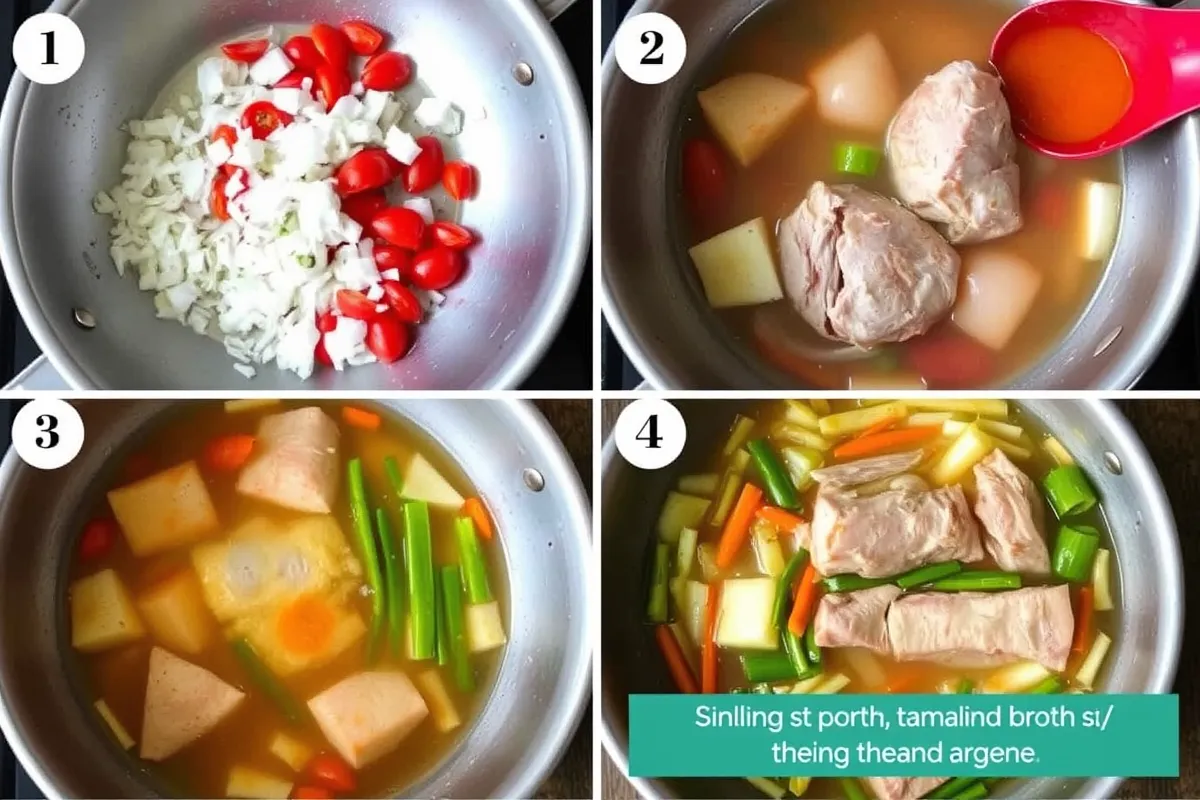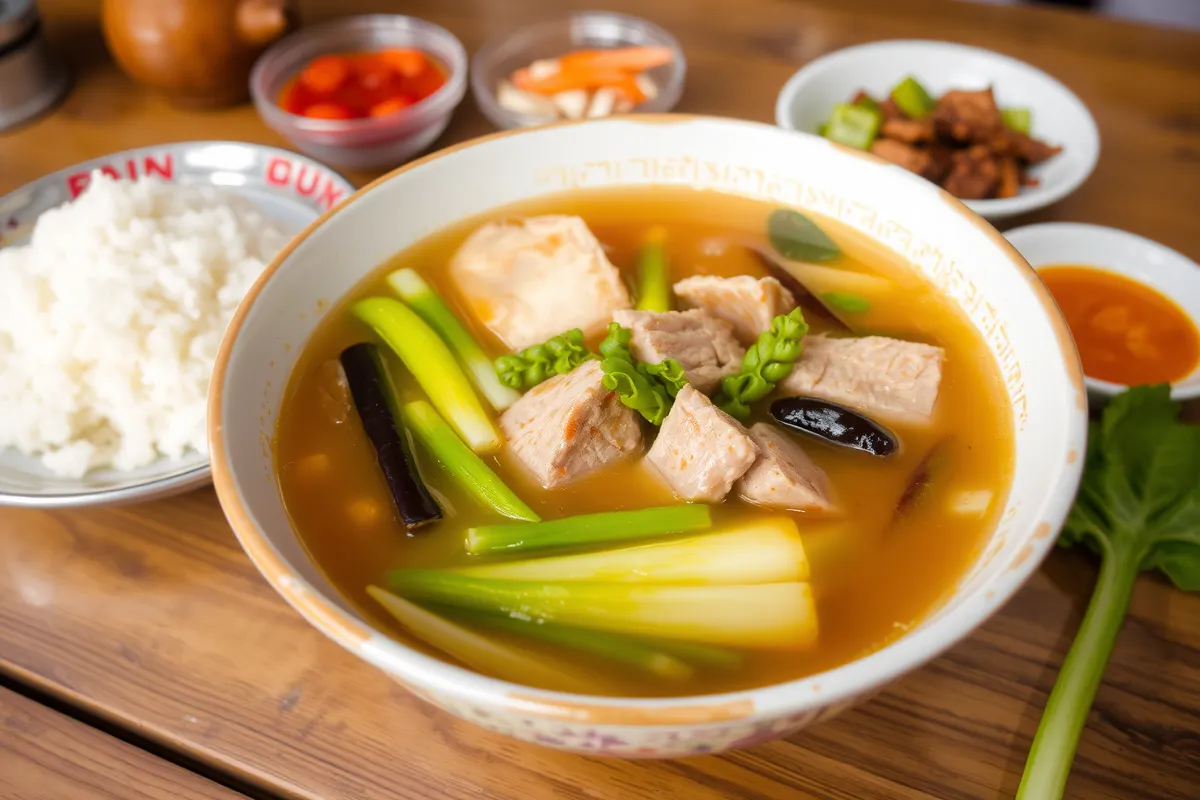Filipino cuisine is brimming with iconic dishes, but few can rival the hearty and tangy appeal of Sinigang. This beloved Filipino soup is known for its sour broth, packed with the goodness of fresh vegetables and proteins. Whether you’re a novice or a seasoned chef, this guide will walk you through every detail, from its origins and essential ingredients to mastering the recipe and experimenting with creative variations. Let’s embark on a flavorful journey that captures the heart of Filipino culinary traditions.
What is Sinigang Recipe ?
Sinigang is a traditional Filipino soup, celebrated for its distinctive sour flavor. The heart of its taste lies in tamarind, a key souring agent that lends a vibrant tang to the broth. Often made with a variety of proteins like fish, shrimp, or chicken, Sinigang is equally loved for its medley of vegetables, which not only add texture but also nutritional value.
This dish is more than just a meal—it’s a cultural emblem, bringing families together over its comforting aroma and satisfying flavors. You’ll find Sinigang served at every occasion, from casual dinners to grand celebrations, a testament to its deep roots in Filipino households.
Why Sinigang Recipe is Loved Worldwide
One taste of Sinigang, and you’ll understand why it holds such universal appeal. Its sour broth is perfectly balanced by the natural sweetness of fresh vegetables, creating a harmony of flavors that’s simply unforgettable.
Filipinos abroad often prepare Sinigang as a nostalgic reminder of home. Its ability to be tailored with various proteins and souring agents also makes it accessible to different palates. Plus, it’s a healthy choice, thanks to its fresh ingredients and cooking methods that preserve nutrients.
Nutritional Benefits of Sinigang Recipe
Beyond its deliciousness, Sinigang boasts an impressive nutritional profile. Tamarind, the main souring agent, is rich in antioxidants, vitamins, and minerals that support overall health. The assortment of vegetables, such as radish, kangkong, and tomatoes, delivers essential nutrients like vitamin C, potassium, and fiber.
What’s more, the proteins used—whether fish, shrimp, or chicken—are lean sources of protein, making Sinigang a wholesome, guilt-free delight. Not only does it nourish the body, but its heartwarming qualities are a treat for the soul too!
One of the reasons Sinigang is a favorite in Filipino households is its nutritional value. Packed with vegetables, lean proteins, and natural souring agents, it’s a wholesome dish that doesn’t compromise on flavor. Here’s an approximate breakdown of its nutritional content per 100 grams.
Nutritional Content of Sinigang (Per 100g):
| Nutrient | Amount | Daily Value (%) |
|---|---|---|
| Calories | 45 kcal | 2% |
| Protein | 4 g | 8% |
| Fat | 1 g | 2% |
| Carbohydrates | 6 g | 2% |
| Dietary Fiber | 2 g | 8% |
| Sodium | 200 mg | 8% |
| Vitamin C | 8 mg | 10% |
| Potassium | 150 mg | 4% |
This table provides a glimpse into the health benefits of Sinigang, which makes it an excellent choice for those looking for a balanced meal. Nutritional values may vary based on ingredients and preparation methods, but Sinigang remains a hearty and nourishing dish!
This sets the stage for understanding the essentials and delving deeper into the fascinating world of Sinigang. Up next, we’ll explore the ingredients that make this dish so unique.
The Essential Ingredients of Sinigang Recipe
When it comes to Sinigang, every ingredient plays a starring role in creating its signature tangy, comforting flavor. From the souring agent to the fresh vegetables, each component contributes to the dish’s rich complexity.
Key Ingredients in a Classic Sinigang Recipe
The soul of Sinigang lies in its carefully chosen ingredients. While there are numerous variations of this dish, certain staples define its essence:
Tamarind as the Souring Agent
Tamarind is the heart and soul of traditional Sinigang. Its pulp, known for a perfect balance of tartness and natural sweetness, creates the broth’s defining flavor. Fresh tamarind pods are often boiled and strained to extract their essence, but tamarind paste or concentrate can also be used for convenience.
Proteins: The Heart of the Dish
Sinigang is versatile when it comes to proteins. The most popular choices include:
- Beef (commonly ribs or belly) for a rich, hearty base.
- Fish, like milkfish (bangus), for a lighter yet equally satisfying version.
- Shrimp, offering a delightful seafood twist.
- Chicken, preferred by those seeking a leaner option.
Vegetables: Adding Flavor and Texture
A mix of vegetables not only elevates the dish’s taste but also adds vibrant colors. Common selections include:
- Kangkong (water spinach): A leafy green that soaks up the broth beautifully.
- Radish: Adds a mild crunch and sweetness.
- Tomatoes: Enhances the broth’s natural tartness.
- Eggplant: Provides a soft, melt-in-your-mouth texture.

Substitutions and Modern Twists
Sinigang is nothing if not adaptable! Whether you’re experimenting with new flavors or catering to dietary restrictions, these substitutions and twists can help you reimagine this classic dish.
Alternatives to Tamarind
If tamarind isn’t available, other souring agents can replicate its tang:
- Calamansi (a small citrus fruit) lends a zesty brightness.
- Lemon is an excellent stand-in for a slightly milder sour note.
- Pre-made sinigang mix offers convenience, combining souring agents and seasonings in one.
Vegetarian and Vegan-Friendly Variations
For a plant-based version, skip the meat and let hearty vegetables take center stage. Tofu or mushrooms can substitute for protein, while the broth retains its flavor with tamarind or miso.
Regional Variations of Sinigang Recipe
Across the Philippines, regions have added their own twists to Sinigang, reflecting local ingredients and culinary preferences.
Sinigang na Baboy (Beef Sinigang)
This classic version is the go-to comfort food in most Filipino households. It features beef ribs or belly, creating a rich and savory broth that perfectly complements the sourness.
Sinigang na Hipon (Shrimp Sinigang)
A coastal favorite, this variation swaps beeffor shrimp, resulting in a light, seafood-infused broth that highlights the tangy tamarind.
Sinigang na Bangus (Milkfish Sinigang)
This variation uses bangus, the national fish of the Philippines, to create a delicate yet flavorful soup that pairs beautifully with rice.
The foundation of a great Sinigang lies in its ingredients, but the cooking process is just as critical. In the next part, we’ll dive into a step-by-step guide to preparing this Filipino treasure.
Sinigang Variations and Fusion Ideas
Sinigang is a culinary canvas for creativity. While the traditional recipe remains beloved, many chefs and home cooks have reimagined this dish, adding exciting twists that highlight its versatility. Let’s explore how Sinigang continues to evolve in both classic and modern kitchens.
Creative Variations of Sinigang Recipe
If you’re feeling adventurous, these unique Sinigang variations are sure to excite your taste buds:
Grilled Sinigang
By grilling the protein and some vegetables before simmering them in the broth, this variation adds a smoky depth to the dish. It’s a fun twist that elevates traditional flavors, especially for barbecue enthusiasts.
Sinigang sa Miso (Sinigang with Fermented Soybean Paste)
This variation combines the sourness of tamarind with the savory, umami-rich flavor of miso paste. Popular with fish or shrimp, Sinigang sa Miso brings a Japanese-inspired flair to this Filipino classic.
Sinigang sa Pakwan (Sinigang with Watermelon)
Perhaps the most unconventional variation, Sinigang sa Pakwan incorporates watermelon for a hint of fruity sweetness that balances the broth’s tanginess. It’s visually stunning and surprisingly delicious!
Sinigang in Modern Cuisine
Sinigang’s flavors have transcended traditional soup bowls, evolving into delightful modern culinary creations that capture its essence in innovative ways.
Sinigang-Flavored Ramen or Pasta
For instance, imagine a bowl of ramen or a plate of pasta infused with the tangy goodness of tamarind broth. Furthermore, this fusion dish is elevated with the addition of traditional Sinigang vegetables, like radish, tomatoes, and water spinach, for authentic flavor. It’s a creative combination that marries the comforting taste of Sinigang with the universal appeal of noodles, making it irresistible to both locals and international food lovers alike.
Sinigang-Inspired Sauces and Marinades
In addition, tamarind-based sauces inspired by Sinigang open up endless possibilities in the kitchen. For example, these tangy, savory sauces can be used to marinate meats, ensuring every bite is packed with flavor. Alternatively, they can be drizzled over grilled vegetables or seafood to create a unique dish that pairs well with rice or salads. The harmonious blend of sour and savory notes adds a bold, exciting twist to everyday meals, turning them into something truly special.
By embracing these modern interpretations, Sinigang proves its versatility, offering new and exciting ways to enjoy its iconic flavors.
Serving and Pairing Sinigang
Sinigang isn’t just a dish—it’s an experience. How it’s served and paired with other items can elevate its appeal even further.
How to Serve Sinigang Recipe
The best way to serve Sinigang is steaming hot, straight from the pot, to capture its full aroma and flavor. It’s typically presented in a large soup bowl, allowing everyone at the table to help themselves.
For a traditional Filipino experience, serve it with a side of plain steamed rice. The neutral taste of rice complements the soup’s tangy flavors, creating a perfect balance in every bite.
Best Side Dishes for Sinigang
Pairing Sinigang with the right side dishes enhances the meal’s overall experience:
- Rice: This is the most common pairing. The rice absorbs the tangy broth, making it even more satisfying.
- Fried Dishes: Sinigang pairs exceptionally well with crispy foods like lumpia (spring rolls) or fried fish, adding a delightful contrast of textures.
With these variations and pairing ideas, Sinigang continues to prove that it’s a dish with endless possibilities. Next, we’ll look into the frequently asked questions about this iconic Filipino favorite.
Frequently Asked Questions (FAQs)
What is the origin of Sinigang?
Sinigang is a traditional Filipino soup deeply rooted in the rich culinary history of the Philippines. Notably, it showcases the country’s reliance on fresh, natural ingredients, such as tamarind, which serves as its signature souring agent. Furthermore, this dish has been a cherished staple for generations, symbolizing warmth, comfort, and togetherness in Filipino culture.
Can Sinigang be made vegan or vegetarian?
Yes, absolutely! With a few thoughtful substitutions, Sinigang can easily transform into a vegan or vegetarian-friendly dish. For instance, you can replace the meat with plant-based proteins like tofu or hearty mushrooms, which soak up the flavorful broth beautifully. Additionally, the dish remains as delicious and satisfying as ever by including tamarind or other souring agents alongside a medley of vegetables like radish, kangkong, and eggplant.
How do I adjust the sourness in Sinigang?
Sinigang’s sourness can be tailored to suit your taste preferences. If you prefer it tangier, simply add more tamarind or try a splash of calamansi juice for a citrusy twist. On the other hand, if the broth feels too sour, you can balance it out with a small pinch of sugar or dilute it with additional water. This flexibility allows you to create a broth that is perfect for your palate.
What is the best meat for Sinigang?
Beef, particularly ribs or belly, is the most popular choice due to its rich flavor. For lighter options, shrimp, chicken, or milkfish (bangus) work wonderfully.
How do you store leftover Sinigang?
Leftover Sinigang can be stored in an airtight container in the refrigerator for up to three days. Reheat it on the stove to preserve its flavors and avoid overcooking the vegetables.
Can Sinigang be frozen for later?
Yes! Sinigang freezes well, especially if you separate the broth from the vegetables to maintain their texture. Store in freezer-safe containers for up to two months. Thaw and reheat gently before serving.
Conclusion
Why You Should Try Making Sinigang Today
If there’s one dish that perfectly encapsulates the warmth and richness of Filipino cuisine, it’s Sinigang. Whether you prefer its traditional preparation or love exploring modern twists, this dish is a culinary gem that continues to win hearts worldwide. Not only is it delicious and comforting, but it’s also versatile enough to suit a variety of tastes and preferences.

